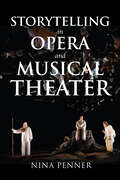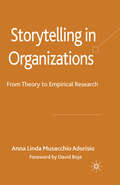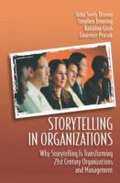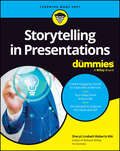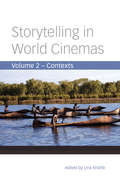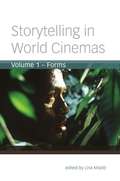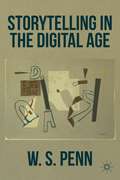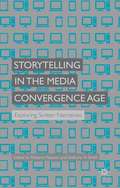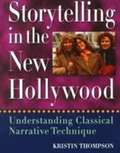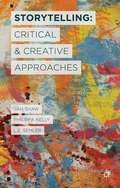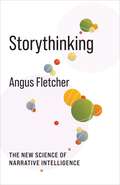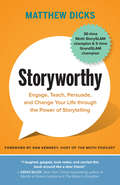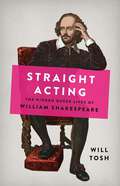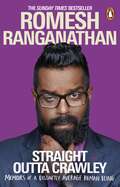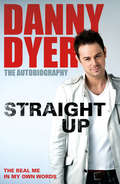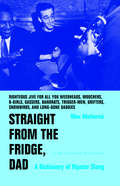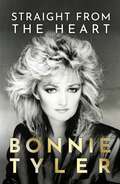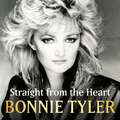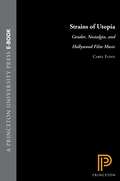- Table View
- List View
Storytelling in Opera and Musical Theater (Musical Meaning and Interpretation)
by Nina PennerStorytelling in Opera and Musical Theater is the first systematic exploration of how sung forms of drama tell stories. Through examples from opera's origins to contemporary musicals, Nina Penner examines the roles of character-narrators and how they differ from those in literary and cinematic works, how music can orient spectators to characters' points of view, how being privy to characters' inner thoughts and feelings may evoke feelings of sympathy or empathy, and how performers' choices affect not only who is telling the story but what story is being told. Unique about Penner's approach is her engagement with current work in analytic philosophy. Her study reveals not only the resources this philosophical tradition can bring to musicology but those which musicology can bring to philosophy, challenging and refining accounts of narrative, point of view, and the work-performance relationship within both disciplines. She also considers practical problems singers and directors confront on a daily basis, such as what to do about Wagner's Jewish caricatures and the racism of Orientalist operas. More generally, Penner reflects on how centuries-old works remain meaningful to contemporary audiences and have the power to attract new, more diverse audiences to opera and musical theater. By exploring how practitioners past and present have addressed these issues, Storytelling in Opera and Musical Theater offers suggestions for how opera and musical theater can continue to entertain and enrich the lives of 21st-century audiences.
Storytelling in Organizations
by Anna Linda Musacchio AdorisioStorytelling in organizations is a notion that encompasses both the stories that the organization produces and the ones told by its members. It provides both an in-depth treatment of the literature on narratives, stories and storytelling and an extensive empirical case from an American banking institution.
Storytelling in Organizations: Why Storytelling Is Transforming 21st Century Organizations and Management
by John Seely Brown Stephen Denning Katalina Groh Laurence Prusak"Storytelling in Organizations" studies how four busy executives found themselves using storytelling to understanding and managing organizations. The authors describe their own experiences working on knowledge management, change management, and innovation strategies in such organizations as Xerox, the World Bank, and IBM.
Storytelling in Participatory Arts with Young People: The Gaps in the Story (Palgrave Studies In Play, Performance, Learning, and Development)
by Catherine HeinemeyerThis book draws on the author’s experience as a storyteller, drama practitioner and researcher, to articulate an emerging dialogic approach to storytelling in participatory arts, educational, mental health, youth theatre, and youth work contexts. It argues that oral storytelling offers a rich and much-needed channel for intergenerational dialogue with young people.The book keeps theory firmly tethered to practice. Section 1, ‘Storyknowing’, traces the history of oral storytelling practice with adolescents across diverse contexts, and brings into clear focus the particular nature of the storytelling exchange and narrative knowledge. Section 2, ‘Telling Stories’, introduces readers to some of the key challenges and possibilities of dialogic storytelling by reflecting on stories from the author’s own arts-based practice research with adolescents, illustrating these with young people’s artistic responses to stories. Finally, section 3, ‘Story Gaps’, conceptualises dialogic storytelling by exploring three different ‘gaps’: the gap between storyteller and listener, the gaps in the story, and the gaps which storytellers can open up within institutions. The book includes chapters taking a special focus on storytelling in schools and in mental health settings, as well as guided reflections for readers to relate the issues raised to their own practice.
Storytelling in Presentations For Dummies
by Sheryl Lindsell-RobertsLearn to influence audiences with storyopia: Stories that take them on a journey from what is to what could be: Storytelling in Presentations For Dummies shows you how to develop and deliver a presentation through storytelling, keeping audience interested, and most importantly, making them heroes that take action towards change. You’ll learn how to cull stories from your own experiences, and before you know it, you’ll have more stories than Aesop has fables. You’ll learn about the latest presentation software, so you can integrate visuals into your presentations and avoid the dreaded “Death by PowerPoint.” You’ll also learn how to deal with challenging on-the-spot situations, deliver investor pitches and executive briefs, and present a paper at a conference. Additionally, find out how to deliver someone else’s content and make it your own. This book will help you level up anywhere you need to present information by mastering the art of savvy presentations—the most effective business communications tools of our time. Identify experiences that can be molded into stories that drive change. Prepare powerful openings to hook your audience right away whether delivering in person, online, or hybrid Have your audience get the most from your presentation with an effective call to action Prepare a storyboard, which is like a frame-by-frame roadmap, that will mesh together what you’ll show and what you’ll tell Leverage software like Canva, Prezi, and Storyboarder to tie your presentation together Enjoy the colorful 8-page mini-booklet, “Storytelling to Storyboarding”This Dummies guide is perfect for any professional who needs to present, and at some time all professionals do. It’s also for entrepreneurs who want to build community and grow their business, in addition to students who want to wow teachers and classmates.
Storytelling in Religious Education
by Susan M. ShawPart I. Foundations of storytelling in religious education Part II. Types of story in religious education Part III. Development and storytelling
Storytelling in World Cinemas
by Lina KhatibStorytelling in World Cinemas, Vol. 2: Contexts addresses the questions of what and why particular stories are told in films around the world, both in terms of the forms of storytelling used, and of the political, religious, historical, and social contexts informing cinematic storytelling. Drawing on films from all five continents, the book approaches storytelling from a cultural/historical multidisciplinary perspective, focusing on the influence of cultural politics, postcolonialism, women's social and cultural positions, and religious contexts on film stories. Like its sister volume, Storytelling in World Cinemas, Vol. 1: Forms, this book is an innovative addition to the academic study of world cinemas.
Storytelling in World Cinemas
by Lina KhatibStorytelling in World Cinemas, Vol. 2: Contexts addresses the questions of what and why particular stories are told in films around the world, both in terms of the forms of storytelling used, and of the political, religious, historical, and social contexts informing cinematic storytelling. Drawing on films from all five continents, the book approaches storytelling from a cultural/historical multidisciplinary perspective, focusing on the influence of cultural politics, postcolonialism, women's social and cultural positions, and religious contexts on film stories. Like its sister volume, Storytelling in World Cinemas, Vol. 1: Forms, this book is an innovative addition to the academic study of world cinemas.
Storytelling in World Cinemas: Contexts
by Lina KhatibStorytelling in World Cinemas, Vol. 2: Contexts addresses the questions of what and why particular stories are told in films around the world, both in terms of the forms of storytelling used, and of the political, religious, historical, and social contexts informing cinematic storytelling. Drawing on films from all five continents, the book approaches storytelling from a cultural/historical multidisciplinary perspective, focusing on the influence of cultural politics, postcolonialism, women's social and cultural positions, and religious contexts on film stories. Like its sister volume, Storytelling in World Cinemas, Vol. 1: Forms, this book is an innovative addition to the academic study of world cinemas.
Storytelling in World Cinemas: Forms
by Ed. Khatib LinaStorytelling in World Cinemas, Vol. 1: Forms is an innovative collection of essays that discuss how different cinemas of the world tell stories. The book locates European, Asian, African, and Latin American films within their wider cultural and artistic frameworks, showing how storytelling forms in cinema are infused with influences from other artistic, literary, and oral traditions. This volume also reconsiders cinematic storytelling in general, highlighting the hybridity of 'national' forms of storytelling, calling for a rethinking of African cinematic storytelling that goes beyond oral traditions, and addressing films characterised by 'non-narration'. This study is the first in a two-volume project, with the second focusing on the contexts of cinematic storytelling.
Storytelling in World Cinemas: Forms
by Lina KhatibAn innovative collection of essays that discuss how different cinemas of the world tell stories.
Storytelling in the Digital Age
by W. S. PennThrough a professional story-teller's sometimes humorous commentary on culture and literature from The Odyssey on, Storytelling in the Digital Age suggests that literature is not an artifact to be studied but a living process. Often irreverent, crossing literary and scholarly lines, W. S. Penn aims to discover what literature does for an imaginatively engaged reader. Aimed to amuse, provoke, and propose ideas, this book makes bold new statements about what it means to be human through an interrogation of a variety of stories told and re-told over thousands of years.
Storytelling in the Media Convergence Age
by Roberta Pearson Anthony N. SmithThis collection investigates the relationship between contemporary screen narratives and their varied contexts of production, circulation and reception, exploring storytelling practices across a range of different media and national and institutional sites. While convergence and globalisation blur the boundaries between media and nations, it is still vital to account for the persistent national, medium, institutional and technological specificities that give rise to different narrative forms. The chapters study the ways in which these factors shape events, characters and settings; inform modes of narrative presentation; influence, via paratextual surround, potential interpretations; and accord certain stories more value than others. The authors use case studies drawn from a range of media, from Hollywood franchises to digital comics, and a range of countries, from United States to Japan. In connecting contemporary screen media narratives to their contexts, this book offers a new perspective on recent transformations in screen media culture.
Storytelling in the New Hollywood: Understanding Classical Narrative Technique
by Kristin ThompsonKristin Thompson offers the first in-depth analysis of Hollywood's storytelling techniques and how they are used to make complex, easily comprehensible, entertaining films.
Storytelling: Critical And Creative Approaches
by Jan Shaw L. E. Semler Philippa KellyThis collection uses the concept of 'story' to connect literary materials and methods of analysis to wider issues of social and political importance. Drawing on a range of texts, themes include post-colonial literatures, history in literature, old stories in contemporary contexts, and the relationship between creativity and criticism.
Storythinking: The New Science of Narrative Intelligence (No Limits)
by Angus FletcherEvery time we think ahead, we are crafting a story. Every daily plan—and every political vision, social movement, scientific hypothesis, business proposal, and technological breakthrough—starts with “what if?” Linking causes to effects, considering hypotheticals and counterfactuals, asking how other people will react: these are the essence of narrative. So why do we keep overlooking story’s importance to intelligence in favor of logic?This book explains how and why our brains think in stories. Angus Fletcher, an expert in neuroscientific approaches to narrative, identifies this capacity as “storythinking.” He demonstrates that storythinking is fundamental to what makes us human. Artificial intelligence can perform symbolic logic, rational deduction, and mathematical calculation, but it is incapable of deliberating in narrative. Drawing on new research in neuroscience and narrative theory, Fletcher explores the nature of imagination, innovation, and creativity. He provides concise answers to big questions: How does storythinking work? Why did it evolve? How can it misfire? What problems can it solve?Revealing the significance of storythinking from science to business to philosophy, this book also provides ways for readers to harness its power to script better tomorrows.
Storyworthy: Engage, Teach, Persuade, and Change Your Life through the Power of Storytelling
by Matthew DicksA five-time Moth GrandSLAM winner and bestselling novelist shows how to tell a great story — and why doing so matters. Whether we realize it or not, we are always telling stories. On a first date or job interview, at a sales presentation or therapy appointment, with family or friends, we are constantly narrating events and interpreting emotions and actions. In this compelling book, storyteller extraordinaire Matthew Dicks presents wonderfully straightforward and engaging tips and techniques for constructing, telling, and polishing stories that will hold the attention of your audience (no matter how big or small). He shows that anyone can learn to be an appealing storyteller, that everyone has something &“storyworthy&” to express, and, perhaps most important, that the act of creating and telling a tale is a powerful way of understanding and enhancing your own life.
Straight Acting: The Hidden Queer Lives of William Shakespeare
by Will ToshA dazzling and "highly readable" (Guardian) portrait of Shakespeare as a young artist, revealing how his rich and complex queer life informed the plays and poems we treasure today &“Was Shakespeare gay?&” For years the question has sent experts and fans into a tailspin of confusion. But as scholar Will Tosh argues, this debate misses the point: sex, intimacy, and identity in Elizabethan England were infinitely more complex—and queer—than we have been taught. In this incisive biography, Tosh reveals William Shakespeare as a queer artist who drew on his society&’s nuanced understanding of gender and sexuality to create some of English literature&’s richest works. During Shakespeare&’s time, same-sex desire was repressed and punished by the Church and state, but it was also articulated and sustained by institutions across England. Moving through the queer spaces of Shakespeare&’s life—his Stratford schoolroom, smoky London taverns and playhouses, the royal court—Tosh shows how strongly Shakespeare&’s early work was influenced by the queer culture of the time, much of it totally integrated into mainstream society. He also uncovers the surprising reason why Shakespeare veered away from his early work&’s gender-bending homoeroticism. Offering a subversive sketch of Elizabethan England, Straight Acting uncovers Shakespeare as one of history&’s great queer artists and completely reshapes the way we understand his life and times.
Straight Outta Crawley: Memoirs of a Distinctly Average Human Being
by Romesh RanganathanTHE SUNDAY TIMES BESTSELLERStraight Outta Crawley is the hilarious and irreverent autobiography from comedian Romesh Ranganathan.'Very, very funny. I can't recommend it highly enough.' Jonathan Ross_________________________________At the age of 9, Romesh Ranganathan delivered his first ever stand-up set at a Pontin's holiday camp talent competition, smashing the other competitor, a young girl playing the kazoo.The gig went so well that Romesh retired his comic genius for twenty-two years, hiding behind the guise of a maths teacher, before finally revealing himself again (no, not like that) at the tender age of 31. In 2010, Ranganathan staged his epic comeback gig to an almost silent room, and has since gone on to earn his place as the most in-demand overweight vegan Sri Lankan comedian in Britain.Now, for the first time, he tells the full story of how he got here. From the delights of Sri Lankan hospitality to his struggles as a child, teacher and now parent, to his adolescent flirtation with a rap career and his attempts to make it in comedy, Straight Outta Crawley is Ranganathan's hilarious and irreverent autobiography.Have you read Romesh's latest book? As Good As It Gets: Life Lessons from a Reluctant Adult is Romesh Ranganathan's hilarious and painfully accurate dissection of what it really means to grow up.
Straight Up: My Autobiography
by Danny DyerGrowing up in the eighties in East London was no picnic. Proper hard bastards, wannabe villains and cockney wide boys everywhere you went, all looking to make their mark. With trouble at home and more at school, Danny Dyer didn't have many options. He was a rascal, running with a tough crowd, getting himself into scrapes with the Old Bill, on the verge of becoming just another nobody. Until he started to act.It came naturally to him. He landed role after role, working with big stars, making a name for himself. And then came Human Traffic, and his career went into overdrive. Fame opened doors into the best clubs, the best booze and even better drugs. But with the highs came the lows, and as the drinks flowed, the work dried up. Shut out of an industry that didn't understand him, that heard his reputation before bothering with his talent, he had no choice but to turn it around and sort himself out. This is the real story - straight up.Funny, honest, full of swagger, and jammed full of antics and anecdotes, this memoir tears it up proper and delivers on every page.
Straight from the Fridge, Dad: A Dictionary of Hipster Slang
by Max DecharneRighteous jive for all you weedheads, moochers, b-girls, gassers, bandrats, triggermen, grifters, snowbirds, and long-gone daddies.Much of the slang popularly associated with the hippie generation of the 1960s actually dates back to before World War II, hijacked in the main from jazz and blues street expressions, mostly relating to drugs, sex, and drinking. Why talk when you can beat your chops, why eat when you can line your flue, and why snore when you can call some hogs? You’re not drunk–you’re just plumb full of stagger juice, and your skin isn’t pasty, it’s just caf? sunburn. Need a black coffee? That’s a shot of java, nix on the moo juice.Containing thousands of examples of hipster slang drawn from pulp novels, classic noir and exploitation films, blues, country, and rock ’n’ roll lyrics, and other related sources from the 1920s to the 1960s, Straight from the Fridge, Dad is the perfect guide for all hep cats and kittens. Think of it as a sort of Thirty Days to a More Powerful Vocabulary for the beret-wearing, bongo-banging set. Solid, Jackson.
Straight from the Heart: BONNIE TYLER'S AUTOBIOGRAPHY
by Bonnie TylerThe honest and heartfelt memoir of vocal powerhouse and music legend Bonnie TylerYou know the name and you can't mistake the voice. Now you can read the incredible story of how a shy, music-loving teenager called Gaynor Hopkins became legendary international superstar Bonnie Tyler, and carved out an extraordinary career that is still going strong to this day.After five decades in the business - during which she has recorded some of the most iconic songs of all time, including 'Total Eclipse of the Heart' and 'Holding Out for a Hero' - Bonnie is at last sharing her fascinating journey, and she's not holding back: this is her amazing story, told straight from the heart.
Straight from the Heart: BONNIE TYLER'S LONG-AWAITED AUTOBIOGRAPHY
by Bonnie TylerThe candid and heartfelt memoir of vocal powerhouse Bonnie TylerWe all know the name, and we all know that voice, but what the world doesn't know is how Bonnie Tyler came to be the vocal powerhouse that took the music industry by storm. Now, after nearly 50 years in the limelight, Bonnie will lift the lid on her private life: her 50-year marriage, health, family, friendships, and fallouts with the world's biggest stars. Bonnie's is a fascinating, whirlwind of a life, and here, for the first time, she tells the whole story with no filter. The Welsh 80s pop legend tells her story of humble start in a small mining town in South Wales where she lived with her large, loving and eclectically musical family. From singing in church, her incredible voice surprising the congregation, to performing in pubs, to becoming a global icon and national treasure, throughout her successful career she has remained true to herself and her beginnings. This year marks the 40th anniversary of Total Eclipse of the Heart, one of the most famous power ballads of all time. Now as Bonnie approaches 50 years in the business she continues to move with the times, releasing new music and constantly touring the world.A happy childhood of music and freedom is conjured up here, along with the trickier side to being a woman in the music industry in the 1980s. Bonnie will speak with her characteristic no-nonsense humour and candour to create an inspiring and entertaining story of success, longevity and staying true to your roots.(P)2023 Hodder & Stoughton Limited
Straight from the Heart: BONNIE TYLER'S LONG-AWAITED AUTOBIOGRAPHY
by Bonnie TylerYou know the name and you can't mistake the voice. Now you can read the incredible story of how a shy, music-loving teenager called Gaynor Hopkins morphed into legendary international superstar Bonnie Tyler and carved out an extraordinary career that is still going strong to this day.After five decades in the business - during which time she has recorded some of the most iconic songs of all time, travelled the world and performed for royalty and the Pope - Bonnie is sharing her fascinating journey for the first time. And she's not holding back. From her early days growing up in a tiny mining village in South Wales, to her career as a club singer that led to her accidental discovery by a talent scout, the Top of the Pops devotee had no idea she would one day grace the infamous illuminated stage alongside some of her biggest idols. Her rise to fame would sound like a fairy tale if it wasn't all true.Bonnie has always determinedly followed her own path, even when sceptical music execs told her she would fail. Her bravery led to her working with the legendary producer and songwriter Jim Steinman, going on to record the classic power ballads 'Total Eclipse of the Heart' and 'Holding Out for a Hero', as well as duetting with some of the best-known names in the business. She is undoubtedly one of the biggest vocal powerhouses of her generation, but her roots remain firmly in her beloved Wales. She is resolutely down to earth, funny and endlessly charming. Whether she's talking about the family she adores or sharing hilarious anecdotes from her many years in the spotlight, Bonnie never fails to entertain.Finally, we get to hear the amazing tale of a woman who has led the way for so many other female artists - and has had a bloody great time doing it. Bonnie's much-anticipated memoir is inspirational, moving and straight from the heart.
Strains of Utopia: Gender, Nostalgia, and Hollywood Film Music
by Caryl FlinnWhen Dmitri Tiomkin thanked Johannes Brahms, Johann Strauss, Richard Strauss, and Richard Wagner upon accepting the Academy Award for his score of The High and the Mighty in 1954, he was honoring a romantic style that had characterized Hollywood's golden age of film composition from the mid-1930s to the 1950s. Exploring elements of romanticism in film scores of composers ranging from Erich Korngold to Bernard Herrmann, Caryl Flinn argues that films tended to link music to the sense of an idealized, lost past. Just as the score of Gone with the Wind captured the grandeur of the antebellum South, others prompted flashbacks or suggested moments of emotional intensity and sensuality. Maintaining that many films treated this utopian impulse as a female trait, Flinn investigates the ways Hollywood genre films--particularly film noir and melodrama--sustained the connection between music and nostalgia, utopia, and femininity. The author situates Hollywood film scores within a romantic aesthetic ideology, noting compositional and theoretical affinities between the film composers and Wagner, with emphasis on authorship, creativity, and femininity. Pointing to the lasting impact of romanticism on film music, Flinn draws from poststructuralist, Marxist, feminist, and psychoanalytic criticism to offer fresh insights into the broad theme of music as an excessive utopian condition.
